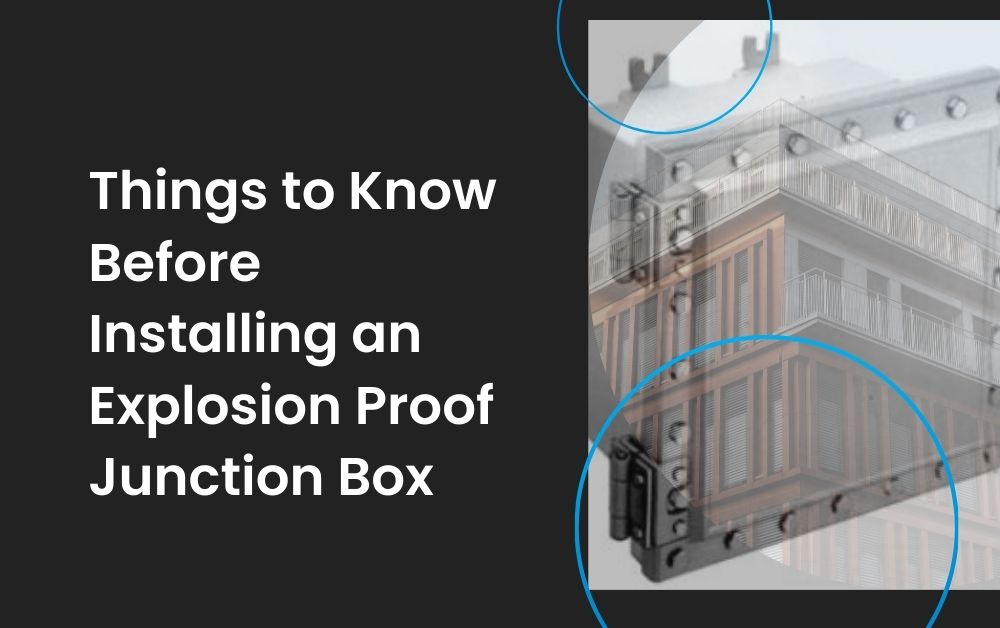Explosion proof junction boxes are critical components in industries where safety from explosions is a top concern. These junction boxes are designed to contain any internal explosions, preventing them from igniting the surrounding hazardous atmosphere. Before you install an explosion proof junction box, there are several important factors to consider. This guide will help you understand what you need to know to ensure a safe and compliant installation.
Understanding Explosion Proof Junction Boxes
What is an Explosion Proof Junction Box?
An explosion proof junction box is a specially designed enclosure that houses electrical connections in environments with flammable gases, vapors, or dust. These boxes are built to withstand and contain any internal explosions, ensuring that no sparks or flames escape to ignite the external environment.
Why Are They Necessary?
Explosion proof junction boxes are necessary in industries such as oil and gas, chemical manufacturing, mining, and any other environments where explosive atmospheres are present. They are essential for maintaining safety and compliance with industry regulations.
Key Considerations Before Installation
Know Your Hazardous Area Classification
Before installing an explosion proof junction box, it is crucial to understand the classification of the hazardous area where it will be used. Hazardous areas are classified into zones based on the likelihood and duration of the presence of explosive atmospheres.
Zone Classifications
- Zone 0: An area where an explosive atmosphere is present continuously or for long periods.
- Zone 1: An area where an explosive atmosphere is likely to occur in normal operation.
- Zone 2: An area where an explosive atmosphere is not likely to occur in normal operation and, if it does occur, will persist for a short period only.
Understanding the zone classification helps in selecting the right type of explosion proof junction box that meets the safety requirements of that specific area.
Selecting the Right Material
The material of the explosion proof junction box is another critical factor. These boxes are typically made from materials like stainless steel or cast aluminum, which are strong enough to contain an explosion.
Material Options
- Stainless Steel: Ideal for corrosive environments, such as offshore platforms or chemical plants.
- Cast Aluminum: Lightweight and suitable for most general hazardous areas.
Choosing the right material ensures the junction box can withstand the environmental conditions it will be exposed to.
Ensuring Compliance with Standards
Explosion proof junction boxes must comply with specific safety standards and regulations. These standards are set by organizations such as the National Electrical Code (NEC), the National Fire Protection Association (NFPA), and the Occupational Safety and Health Administration (OSHA).
Important Standards to Consider
- NEC: Provides guidelines for the installation of electrical wiring and equipment in hazardous locations.
- NFPA: Offers codes and standards to minimize the risk and effects of fire and other hazards.
- OSHA: Regulates workplace safety, including the use of explosion proof equipment.
Ensuring compliance with these standards is essential for legal and safety reasons.
Installation Best Practices
Proper Placement of the Junction Box
The placement of the explosion proof junction box is critical. It should be located in an easily accessible area for maintenance but away from high-risk zones where the likelihood of an explosion is highest.
Placement Tips
- Accessibility: Ensure the box is easily reachable for regular maintenance checks.
- Safety: Place the box away from areas with the highest risk of explosion to minimize potential damage.
Correct Installation Techniques
Proper installation by qualified personnel is crucial for the effectiveness of an explosion proof junction box. Incorrect installation can compromise its ability to contain an explosion.
Steps for Correct Installation
- Inspection: Check the box for any damage before installation.
- Mounting: Securely mount the box to a stable surface.
- Sealing: Ensure all cables and conduits are properly sealed to prevent the entry of flammable substances.
- Wiring: Follow the manufacturer’s instructions for wiring to ensure all connections are secure and safe.
- Testing: After installation, test the box to ensure it functions correctly.
Regular Maintenance and Inspection
Regular maintenance and inspection are vital to ensure the continued safety and functionality of explosion proof junction boxes. Scheduled checks help identify any potential issues before they become serious problems.
Maintenance Checklist
- Visual Inspection: Regularly check the box for any signs of damage or corrosion.
- Seal Integrity: Ensure all seals are intact and not worn out.
- Electrical Connections: Check that all electrical connections are secure and show no signs of wear or damage.
- Functional Testing: Periodically test the box to ensure it is working as intended.
Common Mistakes to Avoid

Ignoring Zone Classification
One common mistake is not considering the correct zone classification when selecting an explosion proof junction box. This can lead to using a box that is not suitable for the specific hazardous area, increasing the risk of an explosion.
Improper Installation
Improper installation is another frequent error. This includes not following the manufacturer’s instructions, incorrect wiring, and failing to properly seal the box. Such mistakes can compromise the safety of the junction box.
Neglecting Maintenance
Neglecting regular maintenance and inspections can lead to unnoticed damage or wear, which can compromise the box’s ability to contain an explosion. Regular maintenance is crucial for long-term safety.
Conclusion: Ensuring Safety in Hazardous Environments
Installing an explosion proof junction box is a critical step in ensuring safety in hazardous environments. Understanding the importance of these junction boxes, knowing the hazardous area classifications, selecting the right material, ensuring compliance with safety standards, following best installation practices, and conducting regular maintenance are all essential steps. By taking these measures, you can help protect both personnel and property from the risks associated with explosive atmospheres.
Note:- For more articles visit on pagetrafficsolution.

